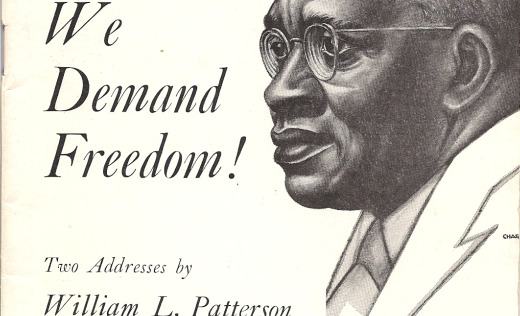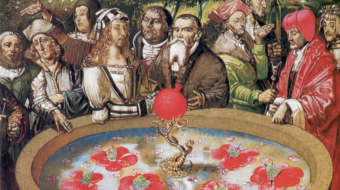
In honor of African American History Month, the third article in our series on the Communist Party’s 90th Anniversary surveys a few documents written by leading African American party members in the struggle against racism. (See first and second articles in the series.) This article limits its focus to one document in each of the following decades – the 1940s, ’50s, ’60s and ’70s.
The first document is a 1943 pamphlet, “The Negro People and the Communists,” by Doxey A. Wilkerson. At this time, Wilkerson was the educational director for the Maryland Communist Party and lecturer at the Jefferson School for Social Sciences.
Before joining the Communist Party, Wilkerson served as chairman of the Department of Secondary Education at Virginia State College; associate professor of education and summer school director at Howard University; research associate of the President’s Advisory Committee on Education; editorial staff member of the Journal of Negro Education; member of the National Advisory Committee on WPA Education Programs; and vice president for both the American Federation of Teachers and the International Labor Defense.
In his pamphlet, Wilkerson wrote, “Communists have always understood this need for Negro-white unity better than any other group in society. It was Karl Marx, father of scientific socialism, who during the Civil War pronounced the famous dictum: Labor with a white skin cannot emancipate itself where labor with a black skin is branded.”
He continued, “In its struggle for the working class of our country, the Communist Party has always understood that the achievement of Negro rights is fundamental to the welfare of the people as a whole.”
Wilkerson clearly understood that the struggle for African American equality and working class solidarity in general are connected; we cannot have one without the other.
He wrote, “The Communist Party has deeply influenced the thinking of hundreds of thousands of white Americans, especially in the ranks of organized labor. It has won increasing numbers of allies for the Negro people.”
Undoubtedly, the Communist Party did (and continues to) place unique emphasis on the role of white workers in the struggle against racism.
The second document, from 1951, titled “We Demand Freedom!” reprints two speeches given by Communist Party leader William L. Patterson, who also served as national executive secretary of the Civil Rights Congress, a broad-based civil rights organization that many credit with laying the groundwork, building the infrastructure and training the cadre that would lead to the civil rights movement.
Like dozens of other Communist Party leaders, in the early 1950s Patterson was indicted under the infamous Smith Act, which in effect attempted to outlaw the Communist Party. During this period, communists were being rounded up in every state, jailed and denied their constitutional rights. Patterson’s pamphlet reflects the fear and also optimism of the times.
“We face what must become the greatest American crisis in the fight to defend our constitutional liberties and human rights,” Patterson wrote in response to the conviction of the first 11 Communist Party leaders imprisoned under the Smith Act.
He went on to write, “The continued existence of the Smith Act as an organic part of the law of the land spells the death knell of the democratic principles for which we have fought and bled. It must go in the name of democracy.”
However difficult the struggle for democracy was, Patterson was optimistic, and his optimism was based on one fundamental idea, championed by the Communist Party: unity. “The fight to restore the Bill of Rights can and must be mounted,” he wrote. “The American people are not indifferent to the needs of the moment. Unity in struggle is the guarantee of victory. White men, women and youth must understand that the key to the unity of progressive America lies in the unity of black and white.”
In 1951, Patterson was 60 years old. He had committed his life to the struggle for workers’ rights, equality and socialism; he had served as the national secretary of the International Labor Defense, where he led a worldwide struggle to defend the nine innocent Scottsboro Youth; he had helped save the Trenton Six -African American New Jersey youth wrongfully charged with murder; he led the defense of the Martinsville Seven in Virginia -black youth charged with the rape of a white women – andheaded the defense of Willie McGee; he presented the landmark study “We Charge Genocide” to the United Nations General Assembly, charging the United States with genocide of the African American people; during the 1960s he defended Angela Davis (who later became a member of the Communist Party) and other members of the Black Panther Party.
The third document is a1967 pamphlet, “Black Power and Liberation: A Communist View,” by Claude Lightfoot. Lightfoot was a prominent Chicago party leader who ran for the Illinois Legislature in 1932 on the Communist Party ticket (receiving over 33,000 votes), served in the armed forces during World War II, was indicted under the Smith Act, and served as secretary of the Communist Party’s National Committee in charge of the Department of Negro Affairs.
“Black Power and Liberation: A Communist View,” provides a glimpse of the realities of the mid-1960s people’s movement. “The present moment can be characterized as one charged with great economic, political and social turbulence,” Lightfoot wrote.
He continued, “In every aspect of American life there is an unprecedented degree of dissatisfaction. The people are striking back. Sometimes they strike according to plan. Sometimes they erupt spontaneously. And sometimes they hit out blindly. But whatever the form they take, these are all struggles by the people against a system that hurts so many of them.”
“Basically, this growing strife arises from a capitalist system in decay,” he added.
On black-white unity Lightfoot wrote, “The struggle for Negro and white unity must go forward today in new forms. Yesterday’s approach is too mild to meet the problems of this stormy period. The question is no longer one of just talking about black and white unity; the problem is how to forge such unity on the basis of complete equality for black people.”
The forth document, “Black Liberation: A Draft Resolution,” by Jarvis Tyner, isn’t dated. It was first drafted in late 1969 and discussed in early 1970, around the time of the founding convention of the Young Workers Liberation League. It was a draft policy statement circulated by the National Organizing Committee for a New Marxist-Leninist Youth Organization – representing Communists, DuBois Club members and independent youth.
Tyner currently serves as executive vice chair of the Communist Party USA. He started his activist career in 1959 fighting against discrimination in employment, housing and social services in his native Philadelphia. Throughout the years he has served as national chair of the DuBois Clubs of America, leader of the Young Workers Liberation League and founding member of the Black Radical Congress,.
In “Black Liberation” Tyner wrote, “A multi-racial Marxist-Leninist youth organization that is weak and/or ineffective in its Black Liberation program, considering the centrality of this question to the United States, will find itself severely crippled in projecting its program in all other areas as well. Moreover, there is a need and tremendous potential for such a youth organization functioning within today’s Black Liberation movement, giving added ideological strength and a stable, lasting, consistent quality to that movement.”
Tyner continued, “It is the continued maintenance of second-class citizenship for the Afro-American that prevents the nation as a whole from achieving even the basic democratic rights. Racism is the chief ruling class weapon that divides and controls the U.S. working class and prevents it from propelling itself into the class struggle with sufficient vigor, militancy and unity. This holds everything back.”
As Wilkerson, Patterson and Lightfoot argued in the 1940s, ’50s and ’60s, Tyner also argued that democracy cannot be achieved without the participation of the entire working class in the struggle against racism.
Tyner noted that there are three aspects to the oppression of African Americans.
First, he wrote, “there is national oppression. This basically identifies the all-class national character of Black oppression, meaning Black people as a national group have a common history (slavery specifically), are all victims of social ostracism and humiliation, economic discrimination, political inequality and racial segregation, regardless of station in life. There is, therefore, a basis for a broad unity of all Black people extending across class lines.”
Second, Tyner added, “there is class oppression. As workers Black people are not just exploited but are super-exploited and a source of massive super-profits for the capitalists.”
“The third aspect of Black oppression – racial oppression – refers specifically to racism and the physical features of Black people as a means by which they can be identified and singled out,” Tyner concluded.
Throughout its 90 years, the Communist Party has placed special emphasis on the struggle against racism. While the forms of struggle have looked quite different from one decade to the next, the substance has remained the same. We find a consistency to the party’s approach to the struggle against racism that transcends time and place; we find a focus, a determination, unequaled in U.S. history.
While the specifics of struggle changed dramatically – be it World War II and the defeat of fascism and the right to full participation in the war effort by African American soldiers, or the broad-based unity built during the McCarthy era that eventually led to the demise of the witchhunts, or the 1960s-era civil rights struggles and antiwar movements – one thing remained constant: the party’s commitment to black, brown and white unity as the only way to build a more just, more democratic society.
Image: From the cover of William L. Patterson’s “We Demand Freedom!”











